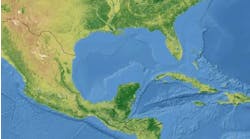In November 2021, Americans were hit with their highest rate of inflation since 1982. With a 6.8% jump in inflation, Americans were dealt a hand that includes surging energy prices. High winter heating bills for consumers are ongoing, and the US must find a way to stem inflationary energy prices while still taking the action Americans want to address the climate challenge.
The American offshore sector provides a path of action that advances much needed economic and energy help while supporting environmental and emissions progress goals across the board – and provides a path that US policymakers should embrace.
Gulf of Mexico oil and gas leasing recently resumed after a court confirmed that the US Department of the Interior is required by law to expeditiously develop America’s energy resources, including the obligation to schedule and hold offshore oil and gas lease sales.
The first – and so far only – Gulf of Mexico lease sale under the Biden administration was held in November. To sum up the sale, it was a win for the American people. The sale generated more than $191 million in winning bids for 308 lease blocks. This was highest winning bids total since March 2019 and the largest number of tracts since March 2014.
Energy companies are increasingly making decisions that incorporate climate and ESG factors and want to produce oil from regions with a low carbon intensity. Every dollar invested reflects the US Gulf of Mexico’s record as a low-carbon energy basin.
The US Gulf of Mexico oil and gas production has a carbon-intensity one-half of other oil producing regions. Deepwater production, which accounts for 92% of production in the Gulf of Mexico, provides the lowest carbon intensity out of any oil producing region.
The US Gulf of Mexico provides the world with a lower carbon energy alternative to oil produced by foreign, higher emitting producers, like Russia and China.
Furthermore, US Gulf of Mexico lease sales support jobs and businesses. More than 345,000 jobs are part of the US Gulf of Mexico oil and gas industry. Every single US state has jobs and investments linked to the Gulf of Mexico.
There are more than 200 types of jobs directly involved in offshore oil and gas projects. These jobs are accessible and have an average salary nearly 30% higher than the national average.
Production in the US Gulf of Mexico also provides substantial revenues for the government to fund critical environmental, conservation and recreation programs. The Land & Water Conservation Fund receives virtually its entire funding from Gulf of Mexico oil and gas production. In 2020, the Great American Outdoors Act (GAOA) was signed into law, which authorizes $900 million annually in permanent funding for LWCF.
The Land & Water Conservation Fund also provides funding for programs like the Outdoor Recreation Legacy Program. More than $30 million has been delegated to more than 50 disadvantaged communities over the past six years to build new parks or improve existing ones in poorer urban neighborhoods, providing safe community oases that normally would not exist.
While the first lease sale of the Biden administration was a success, the future of Gulf of Mexico leasing is uncertain. The most crucial action the administration can take in the new year is the promulgation of a new leasing program before the current one expires this summer. Not only are there the legal requirements which were reaffirmed by the courts last summer, American offshore oil and gas production supports the expansion and development of other critical energy sectors.
Many of the companies that have built up the Gulf of Mexico energy sector over the past 75 years are now turning their experience to spearhead innovations in other offshore energy sectors.
The Biden administration published a new roadmap of when and where new offshore wind leases could be held. The announcement includes seven new lease areas by 2025 off New York, Northern and Central California, Carolina Long Bay, Oregon, the Gulf of Mexico, the Gulf of Maine, and the Central Atlantic.
A recent study by the American Clean Power Association, co-sponsored by NOIA and several other groups, found that these new leases would support $4.5 billion in new federal revenue, create up to 128,000 jobs during construction of the projects, and spark $120 billion in renewable energy investments.
Many of these companies that built the American offshore oil and gas industry are now helping to build up American offshore wind. The success of US offshore wind market is linked to the continued health of the American offshore oil and gas industry.
Going forward, carbon capture, utilization, and storage (CCUS) will be a critical tool in tackling the climate challenge. The US offshore industry is accelerating CCUS progress, and several operators are advancing plans to transport and sequester carbon offshore.
This year can be a momentous year for offshore energy. It marks the 75th anniversary of the world’s first offshore well, located in the Gulf of Mexico, and the 50th anniversary of the National Ocean Industries Association, the voice of the offshore energy industry. As the world continues its energy transition, American offshore energy has not slowed its innovation and energy progress. Our policymakers should seize the energy, economic, and climate solutions the women and men of the offshore energy industry are providing.




